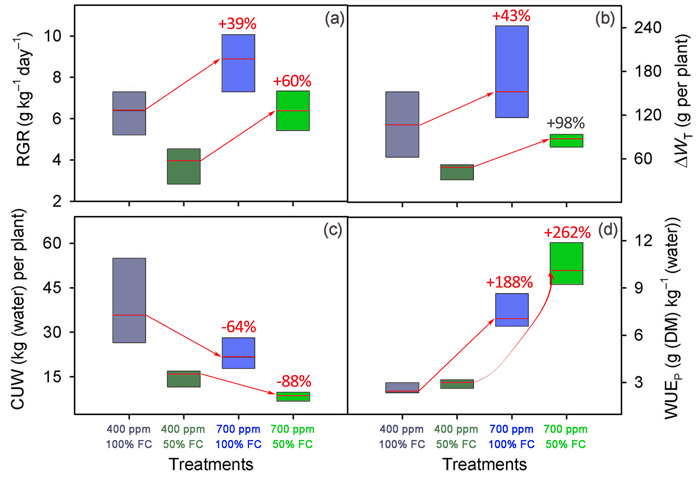| Tweet | Follow @co2science |
Paper Reviewed
de Oliveira, M.F. and Marenco, R.A. 2019. Gas exchange, biomass allocation and water-use efficiency in response to elevated CO2 and drought in andiroba (Carapa surinamensis, Meliaceae). iForest 12: 61-68.
Noting that climate models project the Amazon region could experience periods of prolonged drought in the future in consequence of CO2-induced climate change, de Oliveira and Marenco (2019) set out to "assess the effect of elevated CO2 (eCO2) and drought on photosynthetic rates, water-use efficiency, and biomass allocation in andiroba (Carapa surinamensis)."
In doing so, the two Brazilian researchers exposed six-month-old andiroba saplings to one of two CO2 treatments (ambient = 400 ppm, elevated = 700 ppm), under either well-watered (soil water content kept at 100% field capacity) or drought (soil water content kept at 50% field capacity) conditions for 163 days. The experiment was conducted at the National Institute for Research in the Amazon, Manaus, Brazil in controlled-environment chambers and andiroba was selected as the investigative tree species because it is frequent use in reforestation projects due to its production of high quality wood and oil (carapa oil), the latter of which is extracted from its seeds.
So what did the experiment reveal?
As would be expected, drought negatively impacted the growth of andiroba, whereas elevated CO2 improved it. Relative to ambient CO2 conditions, trees growing in an elevated CO2 environment experienced relative growth rates that were 39% higher under well-watered conditions and 60% higher under drought conditions (see Figure 1a). Consequently total dry matter under well-watered and drought conditions increased 43% and 98% under elevated CO2, respectively (see Figure 1b).
With respect to the trees' use of water, de Oliveira and Marenco observed that total consumptive water use was reduced under elevated CO2 conditions compared with ambient (Figure 1c). Consequently, since trees used less water and produced more mass in the elevated CO2 treatment, it should come as no surprise that their water use efficiencies were greatly enhanced by elevated CO2. And as shown in Figure 1d, such enhancements amounted to whopping 188% and 262% increases under well-watered and drought conditions, respectively.
In light of all the above, it is clear that andiroba tree growth will benefit from rising atmospheric CO2 concentrations, which will stimulate their growth and improve their use of water, especially so during times of drought.

Figure 1. Relative growth rate (RGR, panel a), gain of total dry matter (ΔWT, panel b), consumptive use of water (CUW, panel c) and whole-plant water-use efficiency (WUEP, panel d) of Carapa surinamensis trees grown under two atmospheric CO2 concentrations (400 or 700 ppm) and two water regimes (soil at 50% or 100% field capacity, FC). Red text indicates the percent change in a given parameter due to elevated CO2 under either well-watered (100% FC) or drought (50% FC) soil conditions. Red arrows connect the parameter responses under identical water treatments, but different CO2 concentrations. Source: de Oliveira and Marenco (2019).




